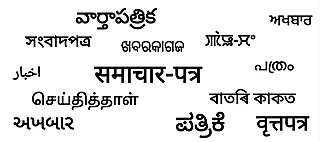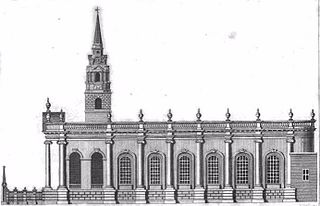The Indian media consists of several different types of communications of mass media: television, radio, cinema, newspapers, magazines, and Internet-based websites/portals. Indian media was active since the late 18th century. The print media started in India as early as 1780. Radio broadcasting began in 1927. Today much of the media is controlled by large, corporations, which reap revenue from advertising, subscriptions, and sale of copyrighted material.

Sir Ashutosh Mukherjee was a prolific Bengali educator, jurist, barrister and mathematician. He was the first student to be awarded a dual degree from Calcutta University. Perhaps the most emphatic figure of Indian education, he was a man of great personality, high self-respect, courage and towering administrative ability. The second Indian Vice-Chancellor of the University of Calcutta for four consecutive two-year terms (1906–1914) and a fifth two-year term (1921–23), Mukherjee was responsible for the foundation of the Bengal Technical Institute in 1906, which was later known as Jadavpur University and the University College of Science of the Calcutta University in 1914.

Hicky's Bengal Gazette or the Original Calcutta General Advertiser was an English-language weekly newspaper published in Kolkata, the capital of British India. It was the first newspaper printed in Asia, and was published for two years, between 1780 and 1782, before the East India Company seized the newspaper's types and printing press. Founded by James Augustus Hicky, a highly eccentric Irishman who had previously spent two years in jail for debt, the newspaper was a strong critic of the administration of Governor General Warren Hastings. The newspaper was important for its provocative journalism and its fight for free expression in India.

The Statesman is an Indian English-language broadsheet daily newspaper founded in 1875 and published simultaneously in Kolkata, New Delhi, Siliguri and Bhubaneswar. It incorporates and is directly descended from The Friend of India, founded in 1818. It is owned by The Statesman Ltd and headquartered at Statesman House, Chowringhee Square, Kolkata, with its national editorial office at Statesman House, Connaught Place, New Delhi. It is a member of the Asia News Network.

The Bengal Presidency, officially the Presidency of Fort William and later Bengal Province, was a subdivision of the British Empire in India. At the height of its territorial jurisdiction, it covered large parts of what is now South Asia and Southeast Asia. Bengal proper covered the ethno-linguistic region of Bengal. Calcutta, the city which grew around Fort William, was the capital of the Bengal Presidency. For many years, the Governor of Bengal was concurrently the Viceroy of India and Calcutta was the de facto capital of India until 1911.
James Hickey may refer to:

Henry Louis Vivian Derozio was an Indian poet and assistant headmaster of Hindu College, Kolkata. He was a radical thinker of his time and one of the first Indian educators to disseminate Western learning and science among the young men of Bengal.
Gurusaday Dutt Road is one of the areas of Kolkata. Its old name was Ballygunge Store Road. It was named after Gurusaday Dutt, an ICS officer and a Bengali patriot.

Hindi media refers to media in Hindi language and its dialects, across the Hindi belt in India, and elsewhere with the Hindi-speaking Indian diaspora.

James Atkinson was a surgeon, artist and Persian scholar — "a Renaissance man among Anglo-Indians".
Vernacular comes from the Latin word vernaculus, which means "native" or "indigenous." Ideally, vernacular is the way ordinary people communicate with each other. In British India, the Vernacular Press Act (1878) was enacted to curtail the freedom of the Indian press and prevent the expression of criticism toward British policies—notably, the opposition that had grown with the outset of the Second Anglo-Afghan War (1878–80). The government adopted the Vernacular Press Act 1878 to regulate the indigenous press in order to manage strong public opinion and seditious writing producing unhappiness among the people of native region with the government. The Act was proposed by Lytton, then Viceroy of India, and was unanimously passed by the Viceroy's Council on 14 March 1878. The act excluded English-language publications as it was meant to control seditious writing in 'publications in Oriental languages' everywhere in the country, except for the South. Thus the British totally discriminated against the Indian Press.
In the last quarter of the 18th century, Calcutta grew into the first major centre of commercial and government printing. For the first time in the context of South Asia it becomes possible to talk of a nascent book trade which was full-fledged and included the operations of printers, binders, subscription publishing and libraries.
James Augustus Hicky was an Irishman who launched the first printed newspaper in India, Hicky's Bengal Gazette.
Parameswaran Thankappan Nair is an Indian scientist, independent researcher, historian and Malayali author based in Kolkata, India, who has written extensively on the history of Calcutta in the English language. He has published 61 books, with 62nd book titled "Gandhiji in Kolkata" to be published soon.

John Zachariah Kiernander (1711–1799), also known as Johann Zacharias Kiernander, was a Swedish Lutheran missionary in India.
Calcutta Gazette was an English newspaper in Bengal founded by Francis Gladwin, a colonial officer, in 1784. It was one of the first newspapers in India.
The Calcutta Chronicle and General Advertiser was a weekly English-language newspaper published in Kolkata, the capital of British India. It was one of the earliest newspapers in colonial India and was published for four years until it stopped its publication under pressure from the East India Company. Two Englishmen, Daniel Stuart and Joseph Cooper, founded the newspaper and also set up the Chronicle Printing Press. A large portion of the newspaper was dedicated to advertisements, and therefore was also called the 'General Advertiser'.
Andrew Otis is an American writer and journalist. Otis is considered an expert on journalism and the early print history of Bengal.

Freedom of the press in British India or freedom of the press in pre-independence India refers to the censorship on print media during the period of British rule by the British Crown on the Indian subcontinent from 1858 to 1947. The British Indian press was legally protected by the set of laws such as Vernacular Press Act, Censorship of Press Act, 1799, Metcalfe Act and Indian Press Act, 1910, while the media outlets were regulated by the Licensing Regulations, 1823, Licensing Act, 1857 and Registration Act, 1867. The British administrators in the India subcontinent brought a set of rules and regulations into effect designed to prevent circulating claimed inaccurate, media bias and disinformation across the subcontinent.







